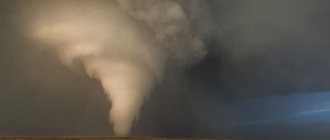Author: tamianni 05/22/2011 21:00
Tornadoes and tornadoes are among the most dangerous natural disasters for humans. Tornadoes arise from thunderclouds. The latter, in turn, are formed in the cyclone zone. Depending on the strength of the cyclone, powerful hurricanes can arise; huge air masses wandering from the open ocean, falling ashore, begin their destructive journey. Whirlwinds ( tornadoes, tornadoes ) are formed from thunderclouds in a matter of seconds, lifting dust and objects into the air, breaking trees and buildings, killing and injuring people. Read more information about the occurrence and nature of this phenomenon here.
The danger of a tornado ( tornado ) lies in its ability to quickly arise and move at enormous speed. Also among the dangers for humans, it is worth noting the following points: a tornado ( tornado , hurricane ) is capable of destroying the strongest buildings, so bridge coverings, structures, overhead power lines, ground pipelines - all this can be involved in the resulting vortex, while moving inside with a huge speed. It is this factor that provides tornadoes with incredible destructive power and danger.
The risk of tornadoes exists primarily in coastal (ocean, sea) areas; in areas remote from the coast, the risk of powerful whirlwinds is reduced. However, there are cases of the formation of powerful tornadoes over open land. So, an example of this is the tornado that visited the Moscow region in 2010. Also see photos of the tornado in our photo gallery.
What to do if you receive an alarm?
Typically, regions potentially exposed to these elements have an established public warning system, so if you live in such an area, when you receive an alarm:
- strengthen the roofs of the building, stove and ventilation pipes;
- seal the windows in the attic (shutters, panels made of boards or plywood);
— free balconies and courtyard areas from fire hazardous items;
- pack food and water for 2-3 days in case of evacuation, and also take documents, the most necessary things (lanterns, candles, clothes, old photographs);
- move from light buildings to more durable buildings or civil defense structures;
How to make sure your loved ones are safe
As a rule, regions that are at risk of natural disasters have an established method of warning and action.
Figure 3. Safety measures during a tornado
When receiving an alarm, you should clearly know how to behave during a tornado or hurricane (Figure 3):
- Strengthen buildings - roofs, stoves and ventilation pipes of buildings, close windows with shutters or boards;
- Clear the yard area and space on the balconies from fire hazards and foreign objects;
- In case of evacuation, collect supplies of food and water for 2-3 days, take with you a first aid kit and documents, the necessary minimum - a flashlight, candles, a spare set of clothes, a radio with batteries, personal hygiene products, a phone with a charger, money;
- Move from light buildings to protective structures of civil defense, take safe places in permanent buildings;
- Don’t forget about your pets - you need to take them into the shelter with you;
- Contact loved ones and relatives, agree on a time for communication, warning them about the disaster.
This is interesting: 6 unexpected tips for survival in the wild that everyone should know
Signs of an approaching hurricane (tornado, tornado)
If meteorological services have not warned the population about an impending cyclone, which could potentially cause a hurricane , tornado ( tornado ), or you are far from civilization without communication with the outside world, you should know the main signs of impending danger:
— increased wind speed (up to 20-30 meters per second);
— a sharp drop in atmospheric pressure;
— heavy rains, storm surge of water;
— rapid snowfall;
— a cluster of dark blue (almost black) thunderclouds on the horizon;
Meeting a tornado in an open area
What to do if danger is detected far from shelter, at home (in nature, on a walk, while traveling, in extreme conditions)?
First of all, you should visually identify the potential threat from the approaching disaster. The stronger the gusts of wind, the precipitation, the darker the horizon, the more quickly you should act. If you have the opportunity to get to serious shelters (house, basement, any strong building), don’t hesitate. Even if your expectations from the approaching mass of clouds do not come true and everything is limited to heavy rain and a couple of lightning bolts, it is better to play it safe.
If circumstances call for you to meet the cataclysm face to face, you should:
- find as open an area as possible. Stay away from trees, rivers, lakes, reservoirs, the sea;
— it is best to hide from a tornado ( tornado , hurricane ) at the bottom of a ditch, hole, ditch, narrow ravine, in a gorge, den (having made friends with the owner in advance), the lowest possible body position increases the chances of remaining unharmed;
- cover your head with clothes, tree branches;
- It is not recommended to be inside a car or other vehicle, get out and follow the instructions above;
We meet a tornado in the building
If the threat of a tornado (tornado, hurricane) overtakes you in a building or you have the opportunity to quickly take shelter in it, you should:
- move away from the windows, take a safe place near the walls of the interior, in the hallway, near built-in closets, in bathrooms, toilets, closets, closets, under tables; if there is one, in the basement (in the USA, almost every private house is equipped with such “shelters”);
- extinguish the fire in the stoves, if any, turn off the electricity and gas;
— turn on the portable radio to receive information from the civil defense headquarters;
- follow the instructions given to you over the radio. If there is none, wait until the weather stabilizes and the tornado threat has passed;
Protecting yourself from tornadoes
It is quite difficult to escape from this type of natural disaster; you can significantly reduce the risk of becoming a victim by following the instructions described in this article, but there are still some practical tips that will save your health and life.
To protect against flying debris, glass shards, and other objects that are carried by a tornado (tornado, hurricane), use sheets of plywood, cardboard and plastic boxes, boards and other available means. Try to quickly take refuge in basements, cellars and anti-radiation shelters available in populated areas . Do not enter damaged buildings, as they may collapse if there are new gusts of wind.
In open areas the range of action is extremely limited. You have the choice to wait out the elements in a secluded place, hiding according to the instructions above, or to run as fast as you can to buildings and shelters that can save you from the deadly whirlwinds of a tornado (tornado).
How to escape from a tornado
Share “How to escape from a tornado”
A tornado that sweeps away everything in its path and sucks in houses, cars and people is not just an American horror film. Tornadoes are also common in Russia, especially in its southern and central regions, as well as in the Far East. However, as the history of meteorology shows, a tornado can form in almost any corner of the globe.
Listen carefully to weather reports in your area, especially in summer. Forecasters will definitely report an approaching storm and/or squally wind, which are harbingers or satellites of a tornado .
If you have a private home, constantly monitor the condition of the residential building and outbuildings. Pay special attention to the condition of the roofs of these buildings. Reinforce the cellar with concrete blocks, but in such a way that if the house collapses or moves, you will not be trapped.
If you live in an apartment, check the condition of the window frames and door frames, so that if it is impossible to shelter from a tornado in the basement (for example, due to the lack of one in many modern houses), you will be relatively safe in the room. Free loggias and balconies from things and especially explosive objects (for example, gasoline or liquefied gas cylinders).
If the radio reports an impending storm and the possibility of a tornado , close all doors and windows and lie down on the floor, under the bed or under the closet, if it is not possible to go down to the cellar or basement. Don't forget to turn off the power and turn off the gas.
If a tornado catches you on the street, immediately run to the nearest room and take shelter there. Avoid light buildings, power lines, bridges. Try to stay away from parks, rivers and lakes. Use cardboard or plastic boxes, sheets of plywood, etc. to protect against flying glass shards, tree branches and debris. You will be incredibly lucky if at this time you are literally a few steps from the metro.
If you notice a tornado while in a car, immediately get out of it and take shelter in a building or basement or, if you are outside the city, in hollows, ditches and narrow ravines. Do not go near bodies of water or trees; cover your head with at least clothing while moving.
Source
If you haven't subscribed to our page yet, click " Like " and get the best posts on Facebook!
Facebook comments
Related posts:
This product, known for over 2000 years, will help restore the natural intestinal microflora
At first, the judges did not take the elderly contestant seriously, but then they were amazed by...
10 FAMOUS CHILDREN, what happened to them YEARS LATER
Anti-wrinkle face mask with honey
I was shocked when I realized the MEANING OF THE STICKER ON THE FRUIT! I always thought it was...
10 incredible tricks and experiments that will surprise you
Inside the tornado
If you find yourself inside the funnel of a tornado ( tornado ), if you are lifted into the air, do not resist, do not panic, it is too late to do anything, you are at the mercy of nature . The best thing you can do is take a deep breath and wait for a successful landing. Huge masses of dust and dirt usually accumulate inside the vortex, which can harm your respiratory organs, even to the point of suffocation, so hold on until the last minute and pray for a quick return to Earth.
Read useful materials about survival on our website, be prepared to face natural disasters.
Who and how can receive compensation if a tree falls on a car?
Damage to a car from a fallen tree can only be an insured event under a comprehensive insurance policy; OSAGO does not cover this risk. This is because comprehensive insurance is voluntary car insurance, and OSAGO is driver’s liability insurance.
Car owners whose car is insured against damage can count on compensation under a comprehensive insurance policy, and the insurance contract includes risks such as a dangerous natural phenomenon, natural disaster, falling trees, flooding, etc. To receive payment, the All-Russian Union of Insurers recommends:
- take photographs of damaged objects,
- obtain a certificate from the Ministry of Internal Affairs (certificate form No. 3, which indicates the fact of damage),
- a certificate from the Hydrometeorological Center stating that there was such a natural disaster.
OSAGO owners can only rely on the court, and they will have to prove that the tree that fell on the car was in poor condition - rotten or rotten, and the utility services did not take care to cut it down. The defendant in this case may be the management organization that maintains the house and the surrounding area.
But if it turns out that the car was parked in a place not intended for this purpose, there is practically no chance of winning the lawsuit.
If a tree falls in calm weather, you need to contact the police department of the area where it happened and call a squad. Not the traffic police, since this is not a traffic accident.
They must draw up a report - check the date, date, correctness of the circumstances of the incident and the license plate number of the car. It’s better to photograph all the damage in detail on your phone, and also take close-ups so that you can see the area, ideally with the house number.
And call an independent appraiser. This may be useful for legal proceedings if it is not possible to resolve the case with the company responsible for the territory in pre-trial proceedings.
Tornadoes and tornadoes are among the most dangerous natural disasters for humans. Tornadoes arise from thunderclouds.
The latter, in turn, are formed in the cyclone zone. Depending on the strength of the cyclone, powerful hurricanes can arise; huge air masses wandering from the open ocean, falling ashore, begin their destructive journey.
Whirlwinds ( tornadoes, tornadoes ) are formed from thunderclouds in a matter of seconds, lifting dust and objects into the air, breaking trees and buildings, killing and injuring people. Read more information about the occurrence and nature of this phenomenon here.
The danger of a tornado ( tornado ) lies in its ability to quickly arise and move at enormous speed. Also among the dangers for humans, it is worth noting the following points: a tornado ( tornado , hurricane ) is capable of destroying the strongest buildings, so bridge coverings, structures, overhead power lines, ground pipelines - all this can be involved in the resulting vortex, while moving inside with a huge speed.
This is interesting: Making a sleigh for a motorized towing vehicle with your own hands
It is this factor that provides tornadoes with incredible destructive power and danger.
The risk of tornadoes exists primarily in coastal (ocean, sea) areas; in areas remote from the coast, the risk of powerful whirlwinds is reduced. However, there are cases of the formation of powerful tornadoes over open land.
So, an example of this is the tornado that visited the Moscow region in 2010. Also see photos of the tornado in our photo gallery.










